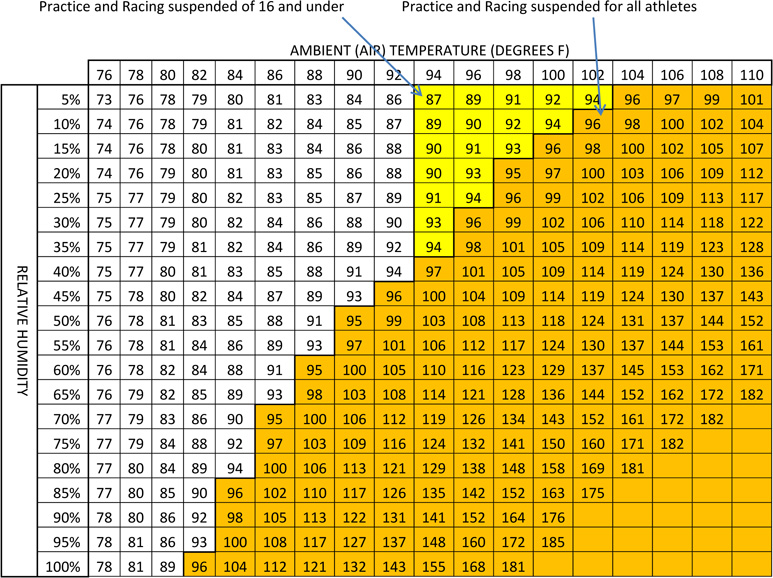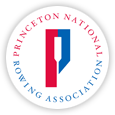Heat stress is a serious health risk. High intensity exercise in a hot environment, with the associated fluid loss and elevation of body temperature, can lead to dehydration, heat exhaustion and heat stroke (which can be fatal). High humidity significantly increases the likelihood of heat stress. Children are at greater risk than adults are because their thermoregulation mechanisms are not fully developed. Older athletes can also be at high risk because of reduced cardiac function.
Competition and practice organizers have a Duty of Care to monitor environmental conditions and to take action to minimize the risk of heat stress to athletes.
- Scope of these Recommendations
These recommendations shall apply to all competitions and practices conducted by the Princeton National Rowing Association, Mercer Rowing Programs on Mercer Lake or run out the Caspersen Rowing Center.
- Structure of the Extreme Heat Recommendations
These recommendations are divided into sections:-
- Activating the Extreme Heat Recommendations
- Heat Index
- Requirements of the Competition Manager/Event Director/Coaches
- Recommendations to Executive Director/Programs Manager/Event Manager
- Important Information – and who suspends racing/practice
- Instruments for measuring Heat Index
- Heat Index Table
- Procedures for reducing the risk of heat stress
- Activating the Extreme Heat Recommendations
The following minimum requirements will determine activation of the Extreme Heat Recommendations. Temperatures are to be deemed at the Caspersen Rowing Center on the side of the course, NOT in direct sunlight.
For competitors 16 years and younger
All practice and racing must be suspended (on completion of the current race) and no further practices or races are to commence if:
The Heat Index is 95°F or greater
The Absolute Temperature is 93°F or greater
For competitors over 16 years of age (Open)
All practices and racing must be suspended (on completion of the current race) and no further practice or races are to commence if;
The Heat Index is 95°F or greater
- Heat Index
The Heat Index shall be determined from the Heat Index Table enclosed by using the Ambient Temperature and the Relative Humidity measured at the Caspersen Rowing Center at the same time. For example, if the Temperature is 95°F and the Relative Humidity is 40%, the Heat Index is a value of 98°F. If the Temperature is 95°F and the Relative Humidity is 60%, the Heat Index is a value of 113°F. See sections 9 & 10 below.
- Requirements of Executive Director/Programs Manager/Event Manager/Coaches
- The weather station located at the Caspersen Rowing Center or if the weather station is not available, an on-line weather service that reports the Temperature, Relative Humidity and/or Heat Index conditions in West Windsor, NJ
- Once the air temperature reaches 77°F, the conditions must be evaluated at least once every hour.
- Once the Extreme Heat Recommendations are invoked, the conditions must be re-evaluated every 30 minutes.
- Where practice or racing is suspended, Executive Director/Programs Manager/Event Manager/Coaches must ensure that all competitors, coaches and managers involved in the regatta are made aware of the action.
- Once the Extreme Heat Recommendations are invoked, the Executive Director/Programs Manager/Event Manager/Coaches must ensure that the minimum rest time between practices or races is one hour.
- Cold drinking water should be made available.
- Cold showers should be made available.
- Ice should be made available for heat stress emergencies.
- Adequate shaded areas should be provided.
- The Executive Director/Programs Manager/Event Manager/Coaches closest advisor on medical matters is PNRA’s Medical advisor or in the case of an event the onsite EMT’s .
- In the case of a heat related medical emergency – 911 should be called.
- Promote awareness of the seriousness of heat stress and the steps that can be taken to reduce the danger by displaying and distributing appropriate information such as the “Drink Up – Beat the Heat” leaflet. The “Beat the Heat” Recommendations as included in the Extreme Heat Recommendations should also be displayed at the Caspersen Rowing Center and at regatta venues.
Note: A coach or a referee at an event will consult with the Executive Director/Programs Manager/Event Manager and may invoke the Extreme Heat Recommendations if he/she believes there is real danger to the competitors’ health.
- Recommendations to Executive Director/Programs Manager/Event Manager
- Have cold water drinking fountains available.
- Encourage competitors to wear hats that cover the top of the ears and back of the necks.
- Avoid scheduling practices and races in the middle of the day when the risk of heat stress is highest. Consider modifying racing distances or practices accordingly.
- Important Information and who suspends practice or racing
- Any coach may suspend practice on account of the weather conditions and may invoke the Extreme Heat Recommendations if he/she believes there is real danger to the participant’s health.
- In the case of a regatta, Referee has the power to suspend racing or postpone any race on account of the weather conditions. The Referee will consult with the chief referee and regatta director and may invoke the Extreme Heat Recommendations if he/she believes there is real danger to the competitors’ health.
- The measurement values used in the Extreme Heat Recommendations determine the level of risk are for an average person involved in continuous strenuous activity in high temperatures. Individual persons will be affected differently by the environmental conditions depending on their:
Fitness level
Athletic ability
Age
Gender
Any predisposed medical conditions
Level of acclimatization
- Upgrading the risk level and even suspending practice or racing may be appropriate in environmental circumstances falling outside the cut-offs listed in the Extreme Heat Recommendations, particularly if Heat Index values are being used – for example, extreme heat combined with high winds.
- Instruments for measuring Heat Index
In using the Heat Index Table provided, Ambient Temperature and Relative Humidity should be measured at the Caspersen Rowing Center or the Mercer Lake Rowing venue. The Caspersen Rowing Center weather station should be utilized. If the weather station is not available then an internet reporting service that reports the conditions in West Windsor, NJ Alternately the Relative Humidity can be determined by using a digital thermometer/hygrometer that can be purchased at electronic stores at a reasonably low cost.
- Heat Index Table
The Heat Index was devised for shady, light wind conditions and does not take into account radiant heat. Direct sunshine and strong, hot, dry winds can significantly increase the “apparent temperature” and thus the risk of heat stress.

- Procedures for Reducing the Risk of Heat Stress
BEAT THE HEAT
High intensity exercise in a hot environment, with the associated fluid loss and elevation of body temperature, can lead to Dehydration, Heat Exhaustion and Heat Stroke.
AVOID HEAT STRESS BY ADEQUATE FLUID REPLACEMENT.
- Racing in hot weather will result in extra fluid loss (dehydration). Even small degrees of dehydration will cause a decrease in performance and this can occur at any stage of a competition, particularly in hot conditions.
- Dehydration contributes to fatigue and may make you more susceptible to cramps, heat stress and heatstroke.
- Children are at a greater risk of heat stress than mature adults.
‘BEAT THE HEAT’ USING THE FOLLOWING MEASURES WHAT TO WEAR
- Wear a hat, cap or visor – a broad brimmed hat is preferred.
- Wear a 30+ sunscreen to prevent skin damage and skin cancer.
- Wear sunglasses to protect your eyes.
- Replace sweat-saturated garments with dry clothing.
DRINK PLENTY OF WATER
- Do Not Wait To Feel Thirsty Before You Drink!
- Sweat is mainly water and a very little salt.
- Drink cool water as it is absorbed more rapidly than warm water.
- If competing for more than one hour, use such as Gatorade or PediaLyte. (salt tablets should be avoided because of their very high sodium chloride content, which can make dehydration worse).
- Thirst is a poor indicator – it is a late signal of severe fluid loss.
- Soft drinks, especially those with caffeine do not rehydrate and should not be used
FLUID REPLACEMENT ROUTINE
- Avoid starting exercise dehydrated (drink plenty of fluids for several hours prior to participating).
- Drink at least 500 ml (2-3 glasses) ½ to 1 hr before a race.
- Drink at least 500 ml to 1 litre (5-6 glasses) after a race and continue to drink until fluid losses are replaced.
SYMPTOMS OF HEAT INJURY OR HEAT STROKE
- Symptoms of heat injury or heat stroke include:
Fatigue
Nausea
Headache
Confusion
Light-headedness
- If you have these symptoms, you should stop competing, drink more fluids and cool down (seek medical treatment if symptoms do not improve rapidly).
